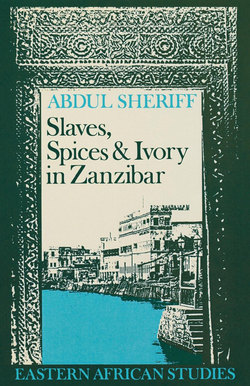Читать книгу Slaves, Spices and Ivory in Zanzibar - Abdul Sheriff - Страница 12
На сайте Литреса книга снята с продажи.
ОглавлениеMaps, Graphs and Tables
MAPS
1.1 The western Indian Ocean
1.2 The monsoons
1.3 The East African coast
2.1 The East African slave trade
2.2 Clove areas of Zanzibar
4.1 Zanzibar: the entrepot, 1846 and 1895
4.2a Differential taxation and the centralisation of trade, 1848
4.2b Differential taxation and the centralisation of trade, 1872–3
5.1 The hinterland of Zanzibar, c. 1873
6.1 The East African slave trade, 1860s
GRAPHS
2.1 Cloves and slaves: production and prices
3.1 Prices of ivory and merekani, 1802/3–1873/4
3.2 Ivory imports into the United Kingdom, 1792–1875
TABLES
2.1 The northern slave trade, 1831 and 1841
2.2 Imports and exports of grains and cereals from Zanzibar, 1859/60–1866/7
2.3 Cloves: production, export and prices, 1830–79
2.4 Value of cloves from Unguja and Pemba, 1859/60–1864/5
2.5 Emancipation of slaves held by Indians, 1860–1
2.6 Prices of slaves at Zanzibar, 1770–1874
3.1 The ivory trade of Mozambique, 1754–1817
3.2 The value of Waters’s contracts with merchants at Zanzibar
4.1 Value of cloves and coconuts in the total exports of Zanzibar, 1859–1864/5
4.2 Value of ivory and copal in the total exports of Zanzibar, 1859–1864/5
4.3 Import duties as a proportion of total revenue, 1859–1864/5
4.4 Internal trade of Zanzibar by commodities, 1859–1864/5
4.5 External trade of Zanzibar by commodities, 1859–1864/5
4.6 External trade of Zanzibar by countries, 1859–1864/5
4.7 The population of Zanzibar town, 1835–1910
4.8 The Indian population of Zanzibar, 1819–74
5.1 Imports into Zanzibar from the African coast, 1848–1873/4
5.2 Exports of ivory from Mombasa, 1849–87
5.3 Mombasa’s foreign trade, 1872
6.1 Slave captures, 1868–70
6.2 The East African slave trade, 1811–73
6.3 Redistribution of slaves in East Africa, 1866/7–1872/3
6.4 The East African slave trade in the 1860s: summary
